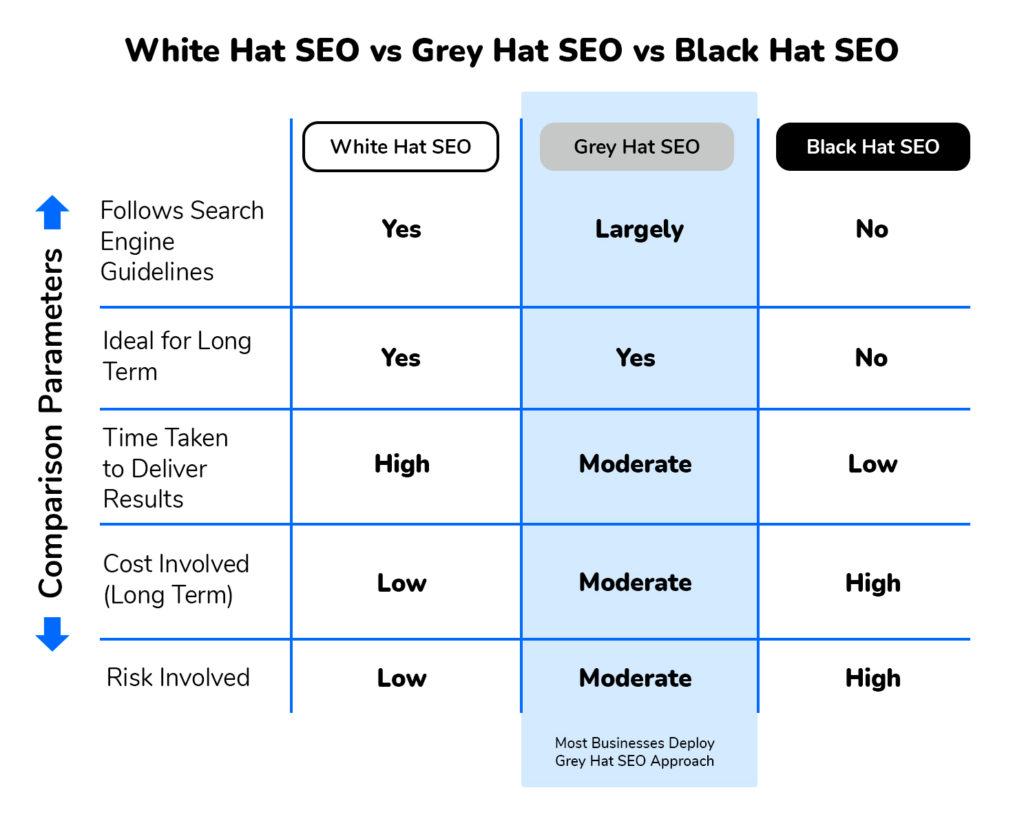Nothing’s black and white in this world. Although Google draws a very clear line between what is acceptable in terms of SEO to attract backlinks and what is clearly not, many activities fall somewhere in between. As opposed to White-Hat SEO (perfectly OK with Google) and Black-Hat SEO (could become reason for penalties from Google), Grey Hat Seo is a big grey zone between the two. What Grey Hat SEO is basically about is exploiting the gaps in Google’s guidelines and algorithms without crossing the line. If a SEO strategy is not explicitly endorsed or condemned as unethical or directly prohibited, it most probably is Gray Hat. In this article, let’s look into the different facets of Gray Hat SEO and make this area slightly less gray in terms of understanding.
Key Characteristics of the Gray Hat SEO
- Ambiguity
Grey Hat techniques usually have to deal with areas where search engine guidelines are not clear-cut. This allows SEO marketers to slightly bend the rules without overstepping.
- Temporary Gains
These techniques can provide quick ranking improvements but carry risks of future penalties. If Google doesn’t penalize certain activities now, there’s no guarantee it won’t happen later.
- Ethical Dilemma
While not outright unethical, Grey Hat strategies are often frowned upon due to their manipulative nature. After all, the keyword for gray hat SEO is exploiting the loopholes.
Gray Hat vs. White Hat vs. Black Hat SEO Techniques

At first sight, the boundaries between, at the least, white hat and black hat SEO may seem ver clear, but if you get down to particular cases, it’s not. For instance, let’s take an influencer collab. You do pay for it, an influencer posts a piece of content that’s related to you, links back and even marks the link as a nofollow. It’s paid – so, Google would think it bad. But it’s marked as a nofollow, so you honestly tell Google about it and let it know not to include this link in calculation of your search rank. But the influencer’s audience is very receptive to your content and starts actively sharing and reblogging and linking back to you. So, this traffic is purely organic, but it is a result of an activity you paid for. Not so simple to determine where this kind of SEO falls, right?
For example, here are some statistics about how wide-spread gray hat SEO actually is.

White Hat SEO: Involves ethical practices that mean to observe search engine guidelines. Techniques include quality content creation, organic link building, and proper keyword usage.
Black Hat SEO: Involves unethical practices that violate search engine guidelines. Techniques include hidden text, link farming, and spamming.
Grey Hat SEO: Lies between White and Black Hat SEO, exploiting areas where guidelines are unclear. Techniques include cloaking, reciprocal links, use of expired domains. It provides short-term benefits but there are also risks of future penalties.
Common Grey Hat SEO Techniques
Now, let’s speak about gray hat SEO techniques and strategies. There’s no definite list of those, and you will find that most marketers will not agree on one. For instance, some consider guest posting as a perfectly white hat SEO technique while others will brand it gray hat or even black hat, if it’s paid for and obviously irrelevant. Here are some common gray hat SEO examples.
- Cloaking
Basically cloaking is when your website displays a different content to users and search engines. If your content features all the right and relevant keywords, snippets, descriptions and metas, it may be perfect for a website, but it may be downright unreadable for users. Your audience may get easily irritated if what they see is a piece of content that is too obviously SEO optimized.
Why is It Gray Hat?
Well, it’s bordering on deceit, obviously. While search engines generally tend to disapprove of it, strategic pinpoint cloaking may still be useful and overlooked, if you’re not overdoing it. Sometimes it’s just impossible to create a piece of content that is both perfectly optimized for SEO and for a smooth user experience.
- Keyword Stuffing with Modifications
This is when you do overload your text with relevant keywords, but modify them slightly to avoid being tagged as keyword-stuffed. For example, instead of using ‘cheap diet plan’ you use ‘affordable diet plan’ and ‘low-price diet plan’. They mean strictly the same thing, but since they are worded differently, to a search engine they won’t come across as keyword stuffing.
Why is It Gray Hat?
Google expressly warns against keyword stuffing. However, by slightly changing your wording you can make your text be a little more natural. It pretty much allows you to skirt the thin line between keyword stuffing and a natural keyword distribution.
- Duplicate Content with Alterations
When you create multiple pages with similar content but slight changes, you’re using a common Grey Hat technique. This method aims to capture more search traffic by appearing as different pages. However, the line between slightly changed and almost the same is pretty thin, so this technique is pretty risky. Even more so now, in light of the most recent updates to Google Algorithms, which focus heavily on content uniqueness.
Why is it Gray Hat?
You’ve seen it. You’re searching for a very specific or marginal case and judging by the meta description in the SERP, you’ve found it. But when you click and open it, it’s just another generic thing optimized for particular keywords that you used. Google condemns it because this tactic offers no new value and a poor user experience.
- Gray Hat Link Building
SEO marketers have long been arguing what type of link building activities are considered gray hat. Usually, exchanging links, using obviously paid link placements, PBNs and expired domains is considered gray hat. Some marketers name guest posting as one of the gray hat tactics.
Why are They Gray Hat?
Because these techniques tend to be overtly manipulative. It is especially noticeable by Google if you’re overusing it. When considering any of these tactics, you have to be very careful and think your strategy through. It may bring short-lived activity bursts, but most of these techniques will have little effect in the long run and can be easily picked up and penalized by the search engines.
- Automation Techniques
Current tech allows you to automate a great many things, from content generation to social media interactions. You can leave it to tools and AI to create fake social media likes, follows and other interactions or generate content that you will market. Sure it saves a lot of time and effort and creates an image of popularity to a certain extent.
Why is It Gray Hat?
Because it’s fake. For instance, if you’re spamming comments with backlinks, you can easily get flagged. Overdoing it with GenAI in terms of content creation may quickly tire your audience who prefer genuine and unique content. AI does develop by leaps and starts, but it still has this uncanny valley quality that is visible to the eye. Today people also easily get the level of visual experience that allows them to quickly spot AI images, for instance.
The inability of today’s GenAI to handle hands and fingers in realistic pictures has even become a meme.

Most people tend to get disappointed when they realize they’re being fed AI-generated content instead of human-crafted. Moreover, recent Google Core updates look at the uniqueness of content and levels of reuse to calculate your SERP score.
Risks and Rewards in Grey Hat SEO
So, why engage in Gray Hat SEO at all? Is it worth your while? Well, it depends how much and how often you do it, whether you are overusing it heavily or it is some last resort means for you to quickly fix a particular situation. Let’s take a closer look.
Rewards
- Quick Results: Grey Hat techniques can sometimes yield faster results in search rankings as compared to White Hat methods.
- Competitive Edge: These techniques can provide an advantage in highly competitive niches.
Risks
- Penalties: Search engines may penalize you for using Grey Hat techniques, leading to ranking drops or bans. Gray hat techniques are often bordering on prohibited and Google is continuously updating its calculation algorithm to include more of them.
- Reputation Damage: If discovered, these practices can harm a site’s reputation and credibility. Sometimes, beyond all repair.
- Algorithm Updates: Search engines continuously update their algorithms, which can nullify the benefits of Grey Hat techniques and lead to penalties.
Boost your SEO results! Link building has become fast and easy with Serpzilla. Buy quality backlinks on authority websites with high DR.

Conclusion
When it comes to Gray Hat techniques, each case is individual. Usually, it all boils down to a SEO marketer’s decision whether to use them or not for various situations. They can provide fast results, but they can also pose risks. The important thing here is to make whatever decisions with careful consideration and well-informed analysis backing them.








